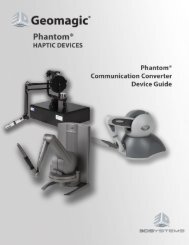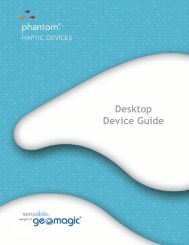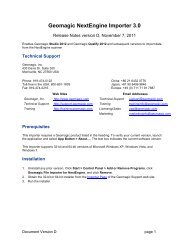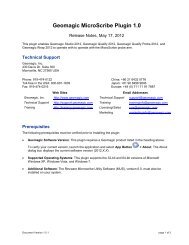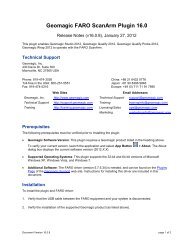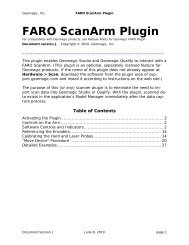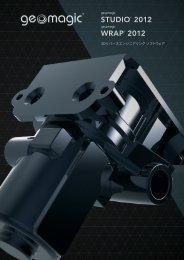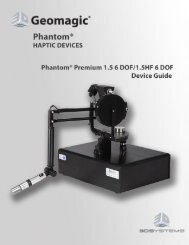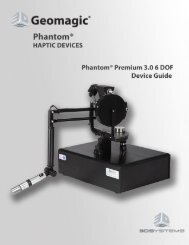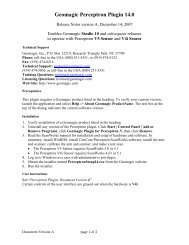Omni Device Guide - Geomagic
Omni Device Guide - Geomagic
Omni Device Guide - Geomagic
Create successful ePaper yourself
Turn your PDF publications into a flip-book with our unique Google optimized e-Paper software.
PREFACEii<strong>Omni</strong> <strong>Device</strong> <strong>Guide</strong>
1 GETTING STARTEDProper Handling and Positioning of the Phantom <strong>Omni</strong> <strong>Device</strong>• There are no specific memory requirements to run the haptic device; however, aminimum of 1 GB RAM is recommended for overall system performance. Any hapticapplication that uses the <strong>Omni</strong> device will have additional memory requirements.• The most current version of the Phantom <strong>Device</strong> driver (PDD). See the Phantom<strong>Device</strong> Drivers Installation <strong>Guide</strong> for specific PDD requirements.• Supplied 6-6 pin FireWire cable. Laptop Users please note that we recommend usinga 6-6 pin cable and add-in card instead of 6-4 pin cable. See www.sensable.com forthe latest information.Proper Handling and Positioning of the Phantom <strong>Omni</strong> <strong>Device</strong>Warning Gripping and lifting the Phantom <strong>Omni</strong> device improperly maydamage it. To reduce the risk of damage, please follow the instructions below.Handling the Phantom<strong>Omni</strong> <strong>Device</strong>Calibrating the device: The Phantom <strong>Omni</strong> may need to be recalibrated from time totime, particularly if it has lost power. To calibrate the device, place the stylus in theinkwell and start your haptically enabled application. The indicator light in the inkwell ofthe Phantom <strong>Omni</strong> device will be lit a steady blue when the device is properly calibrated.Alternatively, you can use the Phantom Test application (Start>All Programs>Sensable.)Lifting the device To properly lift the device grasp the base of the Phantom <strong>Omni</strong> uniton both sides and lift as shown in the image below. DO NOT lift by grasping the stylus orarm. The stylus is detachable by design. Lifting the unit by the stylus or arm could resultin severe damage to the device.Position hands to securely fit the device.<strong>Omni</strong> <strong>Device</strong> <strong>Guide</strong> 1-3
1 GETTING STARTEDProper Handling and Positioning of the Phantom <strong>Omni</strong> <strong>Device</strong>1-6 <strong>Omni</strong> <strong>Device</strong> <strong>Guide</strong>
2Chapter1Installing the Phantom <strong>Omni</strong><strong>Device</strong>This chapter will describe, step by step, how to install the Phantom <strong>Omni</strong> haptic device.The installation is done in two steps.• Install the software, the Phantom <strong>Device</strong> Driver, that allows your computer tocommunicate with the Phantom <strong>Omni</strong> device.• Connect the hardware, the Phantom <strong>Omni</strong> device, to your computer and powersource.Installing the Phantom <strong>Device</strong> DriversThe Phantom <strong>Omni</strong> device communicates with the computer through the FireWire port.To enable this, you must install a software driver, called the Phantom <strong>Device</strong> Drivers(PDD), to control the communication.Specific instructions for installing the PDD on Windows XP, Vista and Windows 7systems can be found in the Phantom <strong>Device</strong> Driver Installation <strong>Guide</strong>. For installationinstructions for other operating systems, see the additional documentation shipped withyour device or software product, or contact customer supportNote As with most other software packages, you must have administratorprivileges on the machine in order to install the system. If you are unfamiliar withinstalling software or do not have administrator privileges, please have yourSystem Administrator execute these steps for you.Connecting the Phantom <strong>Omni</strong> <strong>Device</strong>In this section you will setup the Phantom <strong>Omni</strong> device and plug in all of the cables.Note Exact appearance of your equipment may vary from that shown in thefigures.1 Restart your computer after installing the PDD if you have not already done so.2 Position the Phantom <strong>Omni</strong> device in your workspace, using both hands to grasp thebase of the device. See Proper Handling and Positioning of the Phantom <strong>Omni</strong> <strong>Device</strong>for instructions on how to handle the device to reduce the risk of damage.<strong>Omni</strong> <strong>Device</strong> <strong>Guide</strong> 2-1
1 INSTALLING THE PHANTOM OMNI DEVICEConnecting the Phantom <strong>Omni</strong> <strong>Device</strong>3 Attach the stylus. See “Reassembling the detachable stylus” on page 1-5 forinstructions.4 Connect the FireWire cable.5 Connect the power supply as follows:aInsert the round pin from the Sensable-supplied power supply into the back of thePhantom <strong>Omni</strong> device, as shown in the image below.The power cables connected to the back of the <strong>Omni</strong> device.bPlug the power supply into an available AC outlet. (For 110 V the AC outlet mustbe rated for at least 2 Amps; for 220 V AC, at least 1 Amp).2-2 <strong>Omni</strong> <strong>Device</strong> <strong>Guide</strong>
1 INSTALLING THE PHANTOM OMNI DEVICEConnecting the Phantom <strong>Omni</strong> <strong>Device</strong>cInsert the FireWire cable plug correctly into the Phantom <strong>Omni</strong> device.Connect the supplied FireWire cable into either of the two 6-pin FireWire portson the back of the Phantom <strong>Omni</strong> device.d Connect the other end of the FireWire cable to the FireWire port on yourcomputer.Warning Make sure the connector is facing in the correct orientation as shownin the image above.IMPORTANTSensable Technologies uses only FireWire components that exceedthe IEEE 1394 implementation recommendations. Sensable is notresponsible for any damage that may result from using 3rd partycables.6 For Windows® XP Users- After you have connected the Phantom <strong>Omni</strong> device toyour computer, the Microsoft “Found New Hardware Wizard” dialog will appear.(This may take a few moments).Continue as appropriate for your operating system:7 Select Install the software automatically (recommended) and click Next.<strong>Omni</strong> <strong>Device</strong> <strong>Guide</strong> 2-3
1 INSTALLING THE PHANTOM OMNI DEVICERun Phantom Test to Verify Setup8 When the Completing the Found New Hardware Wizard window opens, clickFinish to complete the install process.Run Phantom Test to Verify SetupIn this section you will run the Phantom Test application to confirm that the device isproperly connected and installed.1 Select Start>All Programs>Sensable>Phantom Test.2 If the device is properly connected and installed, the Phantom Test application willopen and you will be in select mode. Gently move the Phantom arm and the Phantomtest application will synchronously display the movement in the display window.If the device is not properly connected, you will receive the following:“The Phantom device named ‘Default Phantom’could not initialize properly.”If you encounter this error message first check to see that the <strong>Omni</strong> is the selecteddevice in the Phantom Configuration tool (via the Control Panel). If you stillencounter problems, reconnect the device and try again.2-4 <strong>Omni</strong> <strong>Device</strong> <strong>Guide</strong>
3Chapter1Using the Phantom <strong>Omni</strong> <strong>Device</strong>This chapter will introduce you to working with the Phantom <strong>Omni</strong> haptic device and thephysical limits of the device’s range of motion. It is important to understand thesephysical limitations so that you do not inadvertently damage the device by forcing it pastits designed limits.Working in 3D SpaceWe have become so accustomed to using a mouse to move around a computer monitorthat we don’t think twice as we move our hand around a desk to move the cursor on thecomputer screen. But there was a time not long ago when this seemingly simple task wasnot second nature; some even found it challenging and were often frustrated as theylearned. If you are new to working in 3D digital space and haptics, working with thePhantom <strong>Omni</strong> device may take a little getting used to. Understanding where objects arein 3D space may take some practice before you are able to move and manipulate objectswith ease and certainty. Be patient with yourself.Physical Limits of the <strong>Device</strong>The Phantom <strong>Omni</strong> device has six degrees of motion provided by six axis points. All thedegrees of motion have physical limits. When you reach one of these limits you will feel asudden stop; this is the mechanical stop designed into the device. Forcing the device pastany of these stops risks damaging the device.Take some time to become more familiar with the location of the mechanical stops of thePhantom <strong>Omni</strong> before using the device by moving the device through its full range ofmotion at each axis point.1 First make sure the device is not active; the inkwell should not be lit. If the inkwell islit, close any haptic applications you have open.2 Grasp the rubber grip of the stylus as you would a pen, with the free end of the stylus(the eraser end of a pencil) pointing toward you and the point of the stylus (the endconnected to the arm) pointing toward the unit. Using the following illustration as aguide, gently move the stylus in all directions to feel each mechanical stop.<strong>Omni</strong> <strong>Device</strong> <strong>Guide</strong> 3-1
1 USING THE PHANTOM OMNI DEVICEPhysical Limits of the <strong>Device</strong>3 Now, you will perform macro movements. That is, you will move the device at the"body", "shoulder", and "elbow" of the Phantom <strong>Omni</strong> device.Up/DownLeft/RightIn/OutMacro movements. Showing movement of the Phantom <strong>Omni</strong> arm and the body.abcStart with large-but gentle movements. See the Figure above. Beginning at thetop, move the arm of the device left/right. The body, sometimes referred to as theturret, of the Phantom <strong>Omni</strong> device will pivot until is reaches a physical limit.Again, do not try to force the device past any of the mechanical stops.Next, move the stylus up/down. The primary movement will happen in theshoulder of the Phantom <strong>Omni</strong> device.Next move it in/out with the primary movement happening in the elbow. Whenyou reach a physical limit, you'll feel one of the device's mechanical stops. Don'tforce the device past any of these stops.Left/RightBack/ForthUp/Down3-2 <strong>Omni</strong> <strong>Device</strong> <strong>Guide</strong>
1 USING THE PHANTOM OMNI DEVICEPhysical Limits of the <strong>Device</strong>4 Next you perform micro movements further down the haptic device, moving thedevice at the stylus, as in the image above.a Holding the stylus with one hand rotate left/right at the top of the yoke.b Next pivot it up/down at the bottom of the yoke where it joins the stylus.c Finally gently twist the stylus back/forth.Now you should have an understanding of the range of motion of the Phantom <strong>Omni</strong>device at each axis point and where its limits are.Warning ALWAYS work with the connected end of the stylus pointing awayfrom you. NEVER rotate the stylus with the point facing you.<strong>Omni</strong> <strong>Device</strong> <strong>Guide</strong> 3-3
1 USING THE PHANTOM OMNI DEVICEPhysical Limits of the <strong>Device</strong>3-4 <strong>Omni</strong> <strong>Device</strong> <strong>Guide</strong>
xAppendix: TroubleshootingApendiThis section provides tips for correcting some common problems encountered with thePhantom <strong>Omni</strong> device. If after following these steps, you cannot resolve the problem,please contact customer support (see Appendix B:, "Customer Support").#1 My Phantom <strong>Omni</strong> does not seem to be working and the <strong>Omni</strong>'s light (located in the“inkwell”) does not come on at all.The inkwell light on the Phantom <strong>Omni</strong> device should be on if the following criteria aremet:• It is receiving power. Check that the power supply is plugged into a working outlet.Then check that the connection between the power supply and the Phantom device ismade correctly.• The device is connect to your PC via the FireWire cable connection. Make sure thatthe FireWire cable is plugged into one of the ports on the back of the Phantom <strong>Omni</strong>device. You may want to switch ports. Make sure the other end is plugged into theFireWire 1394a port on your computer.• It is configured as the current haptic device via the Phantom Configuration tool. AsAdministrator, open the Phantom Configuration tool from the Control Panel. Makesure the <strong>Omni</strong> is selected in the Phantom Model. You may want to set to anotherdevice, such as the Desktop, and reset back to <strong>Omni</strong> and click Apply.#2 The Phantom <strong>Omni</strong> blinks on and off.Your Phantom <strong>Omni</strong> device may not be calibrated properly. This can happen if youunplug it. To correct this situation, place your stylus in the inkwell. During this process,the light should turn a solid blue. You can also open the Phantom Configuration Test andselect the Calibrate tab. The message should read, "The Phantom has already inkwellcalibrated."Then, go to the Test Forces tab. If the light does not turn solid blue, see #1above. If you need further assistance contact Customer Support.#3 The Phantom <strong>Omni</strong> stylus and the cursor in my haptic application seem to be out ofsync.Your Phantom <strong>Omni</strong> device may not be calibrated properly. This can happen if youunplug it. To re-calibrate the device, place the stylus in the inkwell. The light on thePhantom <strong>Omni</strong> device should be a steady blue once calibrated. If the light does not turnsolid blue, see #1 above. If you need further assistance contact Customer Support.#5 I am able to start an application, but even though the light is lit steadily, the devicebehaves strangely when I move it around in a scene.It is possible that there is a defect or a loose connection inside the Phantom <strong>Omni</strong> device.DO NOT ATTEMPT TO OPEN THE DEVICE. Contact Sensable Technical Support.When contacting Support, you may be asked to run the “PHANToM Test” application tohelp with diagnosis. (Start>All Programs>Sensable).<strong>Omni</strong> <strong>Device</strong> <strong>Guide</strong> A-1
APPENDIX: TROUBLESHOOTINGThe following describes the basic features of this test application which you should beprepared to run.• Select the Phantom device which you want to test. Usually this will be “DefaultPhantom”.• Read Encoders - The values being sensed for the positions and rotations of the deviceare dynamically displayed in the window. The stylus switch is ON when the userpresses the front, dark gray button. The presence switch is ON when the user pressesthe second, light gray button. The picture of the Phantom <strong>Omni</strong> should changedynamically as you move the stylus around.• Test Forces - IMPORTANT: Hold onto the stylus when executing this test. Move thesliders with your mouse to generate forces which push against your hand. X controlsforce parallel to the table. Y controls force up and down. Z controls force in and out.• Box Test - Provides a box which you can feel with your Phantom <strong>Omni</strong>. The sides ofthe box should feel flat and the corners sharp.• Quit - Quits the test application.#6 My Phantom <strong>Omni</strong> works fine but the inkwell is never lit.If your <strong>Omni</strong> is performing properly, the LED in the inkwell could have simply burnedout. You can continue to use your device without risking damage to the device. If youhave any questions, contact customer support.#7 How do I connect multiple Phantom <strong>Omni</strong> devices, daisy chaining?To connect more than one Phantom <strong>Omni</strong> device, it is recommended that you use twoseparate FireWire controllers. This is to work around kernal issues in the Microsoftoperating system. Make sure each controller is available on the <strong>Device</strong> Manager, then plugin each <strong>Omni</strong> as before.IMPORTANT Remember to ensure that the connectors are oriented properly to the ports.See Appendix D: “Configuring Multiple <strong>Device</strong>s” for more information.#8 I cannot power on my computer when I have the Phantom <strong>Omni</strong> connected.You may not have a compatible FireWire card.A-2 <strong>Omni</strong> <strong>Device</strong> <strong>Guide</strong>
xAppendix: Customer SupportApendiWarning DO NOT OPEN THE DEVICE. Attempting to open or repair thedevice by anyone other than a certified authorized service center voids themanufacturer warranty and hardware maintenance contract. There are noserviceable components in the Phantom <strong>Omni</strong> device or power supply. You mustreturn the device for servicing.If you encounter any difficulties within your warranty period, you can obtain TechnicalSupport through the three channels listed below. If you are out of warranty and do nothave active maintenance, Technical Support is limited.• If you purchased your Phantom <strong>Omni</strong> device from a distributor, please contact themfirst.• Customer Support can be reached via e-mail at SensableSupport@geomagic.com.• Customer Support can also be reached via telephone:- In the United States: 1-888-736-7225- Outside the United States: +1-781-939-7444<strong>Omni</strong> <strong>Device</strong> <strong>Guide</strong> B-1
APPENDIX: CUSTOMER SUPPORTB-2 <strong>Omni</strong> <strong>Device</strong> <strong>Guide</strong>
xAppendix: Regulatory NoticesApendiFCC Notice (U.S. Only)The Phantom <strong>Omni</strong>® haptic device is classified by the Federal CommunicationsCommission (FCC) as a Class B digital device.Note: This equipment has been tested and found to comply with the limits for a Class Bdigital device, pursuant to part 15 of the FCC Rules. These limits are designed to providereasonable protection against harmful interference in a residential installation. Thisequipment generates, uses and can radiate radio frequency energy and, if not installed andused in accordance with the instructions, may cause harmful interference to radiocommunications. However, there is no guarantee that interference will not occur in aparticular installation. If this equipment does cause harmful interference to radio ortelevision reception, which can be determined by turning the equipment off and on, theuser is encouraged to try to correct the interference by one or more of the followingmeasures:• Reorient or relocate the receiving antenna.• Increase the separation between the equipment and receiver.• Connect the equipment into an outlet on a circuit different from that to which thereceiver is connected.• Consult the dealer or an experienced radio/TV technician for help.Modifications not expressly approved by the manufacturer could void the user's authorityto operate the equipment under FCC rules.The following information is provided on the device covered in this document incompliance with FCC regulations:Product Name: Phantom <strong>Omni</strong>Model Number: 02350Company Name: <strong>Geomagic</strong>, Inc.NOTESAny changes or modifications to the hardware not expressly approved by <strong>Geomagic</strong> couldvoid the user's authority to operate this equipment.This device is to be used with the <strong>Geomagic</strong>-supplied power supply only. Replacementpower supplies are available directly from <strong>Geomagic</strong>.Canadian Requirements:Canadian Department of Communications Radio Interference RegulationsThis digital apparatus, the Phantom <strong>Omni</strong> haptic device, does not exceed the Class Blimits for radio-noise emissions from digital apparatus as set out in the Radio InterferenceRegulations of the Canadian Department of Communications.Règlement sur le brouillage radioélectrique du ministère des Communications.<strong>Omni</strong> <strong>Device</strong> <strong>Guide</strong> C-1
APPENDIX: REGULATORY NOTICESCet appareil numérique, the Phantom <strong>Omni</strong> haptic device, respecte les limites de bruitsradioélectriques visant les appareils numériques de classe B prescrites dans le Règlementsur le brouillage radioélectrique du ministère des Communications du Canada.European Requirements:EN 55022 StatementThis is to certify that the <strong>Geomagic</strong> Phantom <strong>Omni</strong> haptic device is shielded against thegeneration of radio interference in accordance with the application of Council Directive89/336/EEC, Article Aa. Conformity is declared by the application of EN 55022 Class B(CISPR 22).Warning: This is a Class B product. In a domestic environment, this product may causeradio interference, in which case, the user may be required to take appropriate measures.Achtung: Dieses ist ein Gerät der Funkstörgrenzwertklasse B. In Wohnbereichen könnenbei Betrieb dieses Gerätes Rundfunkstörungen auftreten, in welchen Fällen der Benutzerfür entsprechende Gegenmaßnahmen verantwortlich ist.Attention: Ceci est un produit de Classe B. Dans un environnement domestique, ceproduit risque de créer des interférences radioélectriques, il appartiendra alors àl'utilisateur de prendre les mesures spécifiques appropriées.C-2 <strong>Omni</strong> <strong>Device</strong> <strong>Guide</strong>
xAppendix: Configuring MultipleApendi<strong>Device</strong>sIf you want to use more than one Phantom haptic device with your computer, you cancreate as many as 20 uniquely named Phantom configurations. Each named Phantomconfiguration can refer to a particular system configuration that you use frequently. Whichdevice to use is defined by the software application which uses it.To create a new Phantom configuration use the Phantom Configuration Utility.1 From the Start menu, select Settings>Control Panel>Phantom Configuration. ThePhantom Configuration window opens.2 On the hardware tab, click Add.3 Enter a name to call that device, click OK.4 From the Phantom model menu, select the correct model.5 Click OK.<strong>Omni</strong> <strong>Device</strong> <strong>Guide</strong> D-1
APPENDIX: CONFIGURING MULTIPLE DEVICESD-2 <strong>Omni</strong> <strong>Device</strong> <strong>Guide</strong>
xAppendix: Phantom <strong>Omni</strong> Re-ApendiPackaging InstructionsIf you need to transport or ship the device, please follow these packaging guidelines toreduce the risk of damage to the device.ImportantRemember the Phantom <strong>Omni</strong> device is a sensitive piece of electronic equipment andmust be handled with care. Lifting the device by any of the moving parts may adverselyaffect the unit's performance and risks damaging the device. The Phantom <strong>Omni</strong> devicehas a limited range of motion. Forcing the device past these limits risks damaging thedevice. If you have not already done so, please review “Proper Handling and Positioningof the Phantom <strong>Omni</strong> <strong>Device</strong>” on page 3.Shipping Checklist / Packing Materials:You will need the following items to ship the device safely.The packaging materials in which the device was originally shipped:• 1 Medium shipping box• 1 Set of foam inserts (cradles the device)• 6 Pieces of foam padding (lines the inside walls of box)• 2 squares of cardboard (inside bottom and top of box)• Thin, clear, plastic bag• Packing tapePacking the <strong>Device</strong> and AccessoriesFirst package up the Phantom <strong>Omni</strong> device:• If necessary, reassemble the box and arrange the foam inserts..- Line the sides and bottom with the foam padding.- Place cardboard on the bottom of the box.- Fit the bottom foam insert into the bottom of the box.• Orient the Phantom device to fit neatly inside the foam insert. You may need to graspthe Phantom device by the upper arm—the piece with the oblong cutout— in order toposition it properly. DO NOT grab the stylus.• Gently lower the Phantom device into the insert, while maintaining alignment of thePhantom arm to the cutout.<strong>Omni</strong> <strong>Device</strong> <strong>Guide</strong> E-1
APPENDIX: PHANTOM OMNI RE-PACKAGING INSTRUCTIONS• Ensure that the Phantom device is fully seated by pressing firmly on the Phantom<strong>Omni</strong> label.• Check to see that the Phantom arm is fully seated by carefully pressing on the elbowjoint.• Ensure that the Phantom device is fully seated by pressing firmly on the Phantom<strong>Omni</strong> label.• Check to see that the Phantom arm is fully seated by carefully pressing on the elbowjoint.• Place the top half of foam insert over the Phantom device.• Place the stylus, power supply, power cord, and FireWire cable into the Shipping Trayon the top of the foam insert.• Place the Shipping Tray over the foam insert.• Close the box and tape shut.E-2 <strong>Omni</strong> <strong>Device</strong> <strong>Guide</strong>
xAppendix: <strong>Device</strong> SpecificationsApendiProduct specifications are subject to change without notice.Force Feedback Workspace~ 6.4 W x 4.8 Hx 2.8 D in> 160 W x 120 H x 70 d mmFootprint (physical area the base of thedevice occupies on a surface)~ 6 5/8 W x 8 D in ~ 168 W x 203 D mmWeight (device only) 3 lbs 15 oz ~1.47 kgRange of MotionHand movement pivoting at wristNominal Position Resolution > 450 dpi ~0.055 mmBackdrive Friction < 1 oz < 0.26 NMaximum Exertable Force (at nominalorthogonal arms position)0.75 lbf 3.3 NContinuous Exertable Force > 0.2 lbf > 0.88 NStiffnessX axis > 7.3 lbs./inY axis > 13.A lbs./inZ axis > 5.9 lbs./inX axis > 1.26 N/ mmY axis > 2.31 N/mmZ axis > 1.02 N/mmInertia (apparent mass at tip) ~ 0.101 lbm ~ 45 gForce Feedback x, y, zPosition SensingStylus gimbalx, y, z (digital encoders)Pitch, roll, yaw (± 5% linearity potentiometers)InterfaceSupported platformsOpenHaptics® SDK compatibility?Intel or AMD-based PCsYesIEEE-1394 FireWire® port6-pin to 6-pin** Please visit the Support and Resources section of our website for more information(www.sensable.com/support-overview.htm).<strong>Omni</strong> <strong>Device</strong> <strong>Guide</strong> F-1
APPENDIX: DEVICE SPECIFICATIONSF-2 <strong>Omni</strong> <strong>Device</strong> <strong>Guide</strong>



